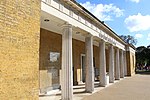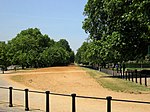The Serpentine

The Serpentine (also known as the Serpentine River) is a 40-acre (16 ha) recreational lake in Hyde Park, London, England, created in 1730 at the behest of Queen Caroline. Although it is common to refer to the entire body of water as the Serpentine, the name refers in the strict sense only to the eastern half of the lake. Serpentine Bridge, which marks the boundary between Hyde Park and Kensington Gardens, also marks the Serpentine's western boundary; the long and narrow western half of the lake is known as the Long Water. The Serpentine takes its name from its snakelike, curving shape, although it only has one bend. Originally fed by the River Westbourne and Tyburn Brook in the 1730s, the lake's water was then pumped from the Thames in the 1830s. The water is now pumped from three boreholes within Hyde Park, the most recent being installed in May 2012 as part of the 2011–2012 restoration of the lake. The Serpentine provided a focal point for The Great Exhibition of 1851, and more recently was a venue for the men's and women's triathlon and marathon swimming events in the London 2012 Olympics. Since 1864, the Serpentine Swimming Club has organised a 100-yard race every Christmas morning. In 1913, the Peter Pan Cup was inaugurated for this race by J. M. Barrie, the creator of the fictional character Peter Pan. There are many recreational facilities around the Serpentine, as well as boating on the lake itself. In 1860, the Serpentine was to be modified into a skating pond with formal edges. This scheme was not implemented. Among the landmarks near the lake is the Diana, Princess of Wales Memorial Fountain.
Excerpt from the Wikipedia article The Serpentine (License: CC BY-SA 3.0, Authors, Images).The Serpentine
Rotten Row, London Knightsbridge
Geographical coordinates (GPS) Address Nearby Places Show on map
Geographical coordinates (GPS)
| Latitude | Longitude |
|---|---|
| N 51.505277777778 ° | E -0.16944444444444 ° |
Address
Serpentine Lido
Rotten Row
SW7 1SE London, Knightsbridge
England, United Kingdom
Open on Google Maps











